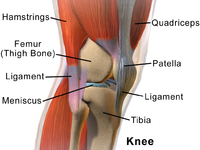
Photo from wikipedia
Knee joint sounds contain information on joint health, morphology and loading. These acoustic signals may be elicited by further, as yet unknown factors. By assessing potential elicitors and their relative… Click to show full abstract
Knee joint sounds contain information on joint health, morphology and loading. These acoustic signals may be elicited by further, as yet unknown factors. By assessing potential elicitors and their relative contributions to the acoustic signal, we investigated the validity of vibroarthrographic assessments during different movement conditions with the aim to derive recommendations for their practical usage. Cross-sectional study. Nineteen healthy participants (24.7 ± 2.8 yrs, 7 females) performed five movements: level walking, descending stairs, standing up, sitting down, and forward lunge. Knee joint sounds were recorded by two microphones (medial tibial plateau, patella). Knee joint kinematics and ground reaction forces were recorded synchronously to calculate knee joint moments (Nm/Kg). The mean amplitude (dB) and the median power frequency (Hz) were determined. A repeated measures mixed model investigated the impact of potential predictors (sagittal, frontal, transverse plane and total knee joint moments, knee angular velocity, age, sex, body mass index (BMI) and Tegner Activity Score (TAS)). Most of the amplitudes variance is explained by between-subject differences (tibia: 66.6%; patella: 75.8%), and of the median power frequencies variance by the movement condition (tibia: 97.6%; patella: 98.9%). The final model revealed several predictor variables for both sensors (tibia: sagittal plane, frontal plane, and total knee joint moments, age, and TAS; patella: sagittal plane knee moments, knee angular velocity, TAS). The standardization of the execution of the activities, a between-group matching of variables and the inclusion of co-variates are recommended to increase the validity of vibroarthrographic measurements during different movement conditions of the knee joint.
Journal Title: Journal of biomechanics
Year Published: 2020
Link to full text (if available)
Share on Social Media: Sign Up to like & get
recommendations!